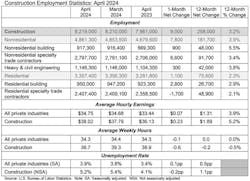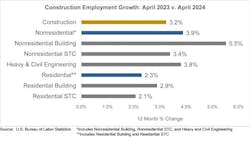Latest from Construction Data
Construction Labor Force Churn Accelerates in January
Sponsored
Nonresidential Construction Employment Strength Persists, Jobs Up 7,800 in April
WASHINGTON, DC — The construction industry added 9,000 jobs on net in April, according to an Associated Builders and Contractors analysis of data released today by the US Bureau of Labor Statistics. On a year-over-year basis, industry employment has increased by 258,000 jobs, an increase of 3.2%.
Nonresidential construction employment increased by 7,800 positions on net, with growth registered in all three major subcategories. Nonresidential specialty trade added the most jobs, growing by 6,600 positions. Nonresidential building and heavy and civil engineering added 900 and 300 jobs, respectively.
The construction unemployment rate fell to 5.2% in April. Unemployment across all industries rose from 3.8% in March to 3.9% last month.
“It is really quite remarkable that the nation’s nonresidential construction sector continues to add jobs so consistently in an environment characterized by elevated project financing costs,” said ABC Chief Economist Anirban Basu. “At the heart of growing demand for construction workers in America is the prevalence of megaprojects in many parts of the country, including major manufacturing plants, data centers and public works.
“Based on ABC’s Construction Confidence Index, there is more hiring to come,” said Basu. “While there is observable weakness in certain industry segments, particularly in the challenging office market, ongoing spending growth in other construction segments has thus far more than fully countervailed that softness. Many megaprojects are just now beginning construction, strongly suggesting a stable US nonresidential construction labor market for months to come. Such considerations are also consistent with relatively rapid increases in construction worker compensation during the balance of 2024.”
Visit abc.org/economics for the Construction Backlog Indicator and Construction Confidence Index, plus analysis of spending, employment, job openings and the Producer Price Index.




